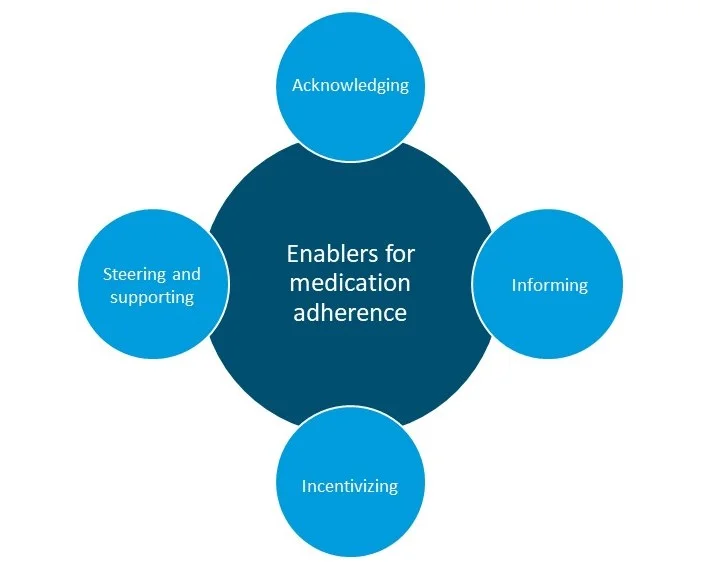Improving health outcome and system efficiency by investing in medication adherence
- The suboptimal use of medicines is a significant challenge faced by health systems globally1.
- Patients who are adherent to medication are more likely to improve health outcomes, avoid complications and premature death as well as less of emergency care and inpatient hospital services1.
- Improving investment in medication adherence is crucial for improving healthcare outcomes, lowering healthcare costs, encouraging better use of pharmaceuticals, and maintaining a sustainable healthcare system2.
In the intricate system of healthcare, medication adherence emerges as a linchpin, weaving together improved health outcomes and heightened efficiency within healthcare systems1. Despite its pivotal role, adherence often remains undervalued or overlooked3. Let’s delve into the profound impact of investing in medication adherence, uncovering its significance beyond individual health to the broader landscape of healthcare delivery. This article will focus on some of the chronic diseases like hypertension, diabetes, and hyperlipidemia where a significant proportion of patients use medication sub-optimally leading to poor health outcome and healthcare costs1.
Why medication adherence should be encouraged?
Treating a disease involves more than just addressing symptoms. It also encompasses fostering effective communication and understanding between patient and providers, as well as aiding patients in developing healthier habits. Adherence to medication can lead to improved health outcomes, a lower risk of complications and premature death, and a reduced need for emergency care and inpatient hospital services1. In contrast, medication non-adherence can result in premature deaths and an increased use of healthcare services1. For example:
- Non-adherence to treatment is nearly twice as high mortality rates for patients with diabetes and heart disease compared to adherent patients1.
- Patients who do not continue to statin therapy face a threefold increase in the risk of heart attacks compared to those who maintain their medication regimen1.
- Non-adherent patients with prescribed beta-blockers for high blood pressure are 4-5 times more likely to experience coronary heart disease complications than adherent individuals1.
Recognizing medication adherence’s impact enables patients to make informed decisions, prioritizing their health, with substantial implications for individual health outcomes and the healthcare system. The World Health Organization (WHO) in its 2003 report on medication adherence highlighted Haynes et al.’s statement that “improving the effectiveness of adherence interventions may have a far greater impact on the health of the population than any improvement in specific medical treatments”4.
How medication adherence benefits healthcare systems?
Poor medication adherence has a ripple effect on health outcomes and the healthcare system at large5. It can lead to:
- Worsening of chronic conditions due to suboptimal disease control1.
- Increased hospital admissions and healthcare costs due to complications that could have been prevented with proper medication use1.
- A higher burden on the healthcare system due to nonadherence6.
- Adherence-promoting interventions are mostly cost-effective and often result in reduced healthcare resource utilization (HCRU) and associated costs7.
Enhancing patients’ adherence to clinical recommendations and treatments provided by healthcare professionals (HCPs) could significantly improve health outcomes and the efficiency of healthcare systems6. Roebuck’s extensive observational study involving 135,000 patients in the United States with diabetes, hypertension, hyperlipidemia, or congestive heart failure revealed a notable correlation: higher adherence levels were linked to significantly fewer annual inpatient hospital days. This reduction ranged from 1.2 days per patient for hyperlipidemia to nearly 6 days for congestive heart failure. Another study demonstrated that non-adherent patients to lipid-lowering therapies (statins) faced a nearly 30% higher risk of emergency department visits compared to adherent individuals1.
Promoting medication adherence, particularly in hypertension, congestive heart failure, diabetes, and hyperlipidemia has demonstrated cost-effectiveness, despite considerations of increased pharmaceutical expenditure. The mean cost-benefit ratios arising from adherence across the four conditions examined were as follows: 1:13.5 for hypertension, 1:8.4 for congestive heart failure, 1:8.6 for diabetes, and 1:3.8 for hyperlipidemia. This ratio incorporated the increase in pharmaceutical spending alongside the decreases in medical spending1.
A study estimated that e-prescribing and the corresponding increase in first-fill medication adherence would save at least $140 billion8. Hence, an additional expenditure of USD on medications for adherent patients with congestive heart failure, hypertension, diabetes, and hyperlipidemia can result in savings ranging between 3-13 USD on emergency department visits and inpatient hospitalizations1.
Economic considerations: Outlining differences between high and low-middle income countries (LMICs)
A WHO report estimated that medication adherence averages around 50% among patients with chronic diseases in high-income country, which is expected to be lower in LMICs9,10. Investing in medication adherence presents economic considerations that differ between LMICs and high-income countries. In high-income country, emphasis lies on more extensive healthcare coverage, better infra-structure, and advanced medical technologies, improving healthcare outcomes and living standards11. Conversely, in LMICs, challenges encompass broader issues like access to healthcare and medication affordability9,10. Here, economic considerations extend to direct medication costs and indirect impacts, such as loss of productivity. Tailored strategies are essential in both settings, considering socio-economic factors like income inequality and cultural beliefs about healthcare.
Strategies to enhance investment in medication adherence
Enhancing investment in medication adherence is crucial for improving healthcare outcomes, reducing healthcare costs, promoting better use of pharmaceuticals, and fostering a sustainable healthcare system2. Some of the strategies are:
- Routine monitoring and reporting
Introducing this strategy could serve as a catalyst for boosting medication adherence. This approach at the physician level has also been proposed to enhance adherence. One method involves supplying physicians with feedback regarding the adherence levels of each of their patients individually1. - Provider-delivered interventions
Healthcare providers (e.g., physicians, pharmacists, and nurses) are ideal to implement interventions that promote adherence as they are aware of the individual need of their patients because of their existing relationships with them, and ongoing monitoring of patients’ health outcomes. However, most of the interventions required additional support as financial incentives1. Some of the interventions included are:- New Medications Service (NMS) – National Health Service (NHS) England has launched the “New Medications Service”. The most extensive national intervention to assist patients in maximizing their medication usage. Under this program, approximately 7 to 14 days following the patient’s visit to the pharmacy for their prescription, the pharmacist offers a consultation to identify any challenges the patient may encounter in taking their medication and help in overcoming adherence barriers1.
- Health Inform – based on providing periodic patient education. The program sent brochures from the participating pharmacy to its patients, containing details about the disease, medication’s effects and potential side effects, administration instructions, and the advantages of adhering to the prescribed regimen. Pharmacist were reimbursed for enrolling the patients in the program1.
- Patient education
Various public educational campaigns to improve medication adherence and create awareness among patients and their family caregivers about the necessity of taking medication as prescribed were carried out. This is frequently considered as a key first step toward better health outcomes. Examples of such campaigns include1:- The Responsável do Medicamento campaign: The campaign was conducted in Portugal and was part of a broader responsible use of medications campaign. This was a joint campaign between the pharmacists’ association and INFARMED (the national authority in charge of medications and health products). This multi-stakeholder campaign includes a website, events, posters, a pledge, and social media1.
- The Adherence, Let’s take care of it: The campaign, which began in 2015 in the United Kingdom, aimed to raise awareness about pharmaceutical non-adherence. The initiative features a website, National Medication Adherence Week, social media, and a pledge1.
- Script your future: This campaign in Unites States includes co-ordinated national communications, paid advertising, and targeted outreach in six cities to raise awareness among patients and their family caregivers about the importance of medication adherence. The campaign focuses on patients affected by three chronic conditions – diabetes, respiratory disease, or cardiovascular disease1.
- Role of financial incentive in medication adherence
Payment reforms and financial incentives for providers have the potential to improve medication adherence1. In a clinical trial, effect of patient financial incentives on statin adherence and lipid control was assessed. The interventions lasted 6 months during which all participants received daily medication reminders and an electronic pill bottle. The result showed financial incentives groups with improved measured statin adherence. The mean LDL-C level reductions from baseline to 12 months were 33.6mg/dL in the control group, 32.4mg/dL in the sweepstakes group, 33.2mg/dL in the deadline sweepstakes group, and 36.5mg/dL in the sweepstakes plus deposit contract group (adjusted P > .99 for each incentive group vs control)12. - Leveraging data and technology infrastructure to boost adherence
Existing or developed Data and technology infrastructure (DTI) might encourage adherence. Many effective strategies for improving adherence involve using technology and information about the individual patient. These approaches analyze data about patients to learn about their specific characteristics, and then customize the interventions to match those traits1. To know more about the personalized medicines, please read: The role of AI in personalized health coaching for adherence.
The pharmaceutical industry also plays key role to improve medication adherence among patients. One such intervention from Abbott is my a:care app – Acare HCP Global (abbott.com). With the help of the “my a:care” app, patients can modify their behavior over time by starting with modest, doable steps and receiving rewards for good behavior. (https://acarepro.abbott.com/tools/help-your-patients-take-control-of-their-health-recommend-the-my-acare-app-to-your-patients-now/)
Enablers for embedding medication adherence in health systems
System level enablers are required for medication adherence. A report has identified four enablers (Figure 1) that might be crucial for improving medication adherence and optimizing therapeutic benefit, and it encourages more coordinated efforts in this direction1.

Figure 1: Enablers of medication adherence1 (This figure is provided for illustrative purposes only and is based on information from Khan R., 2018)
- Acknowledging: This enabler acknowledges the need for medication adherence to be on the policy agenda to develop a systematic approach to improving it. As many individual initiatives are tested and then terminated when resources and priorities alter before their impact is determined. Successes are not always expanded throughout the system. Even the most successful programs may have modest effectiveness. This is frequently due to a lack of identification of the core causes of discontinuing, not adhering to treatment, and failing to address the issue holistically. Therefore, investing in comprehensive interventions that address the healthcare system, with a focus on interactions with healthcare professionals, may offer the most promising outcomes1.
- Informing: There is a need for every country for routine monitoring and reporting adherence at system level which is currently done by only a few. Developing and reporting adherence measures as quality improvement indicators or as performance measures could serve two main purposes: provide transparency and inform decision-making about overall priorities and system level strategies; and inform quality improvement activities of service providers. These measures need to be comparable to benchmark and assess best practice between countries and interventions1.
- Incentivising: The transition to payment systems that compensate providers for better patient outcomes is crucial to provide the incentives and investments needed to improve adherence. Rewarding health professionals’ efforts in resolving patient medication concerns does not always impose a financial burden on organisations and providers; however, by facilitating treatment adherence, it can substantially enhance health outcomes while reducing total treatment time and costs1.
- Steering and supporting: Investing in IT systems to improve patient information access, improving provider-patient interactions, and employing trained HCPs who follow disease-centered care models can all help to increase adherence. Toolkits that help clinicians create therapeutic goals and match patients to treatments improve adherence. Industry innovations such as streamlined regimens, smart packaging, and technological solutions (e.g., apps) can improve therapy follow-up, permit remote communication, provide electronic reminders, and empower patients to track adherence1.
Conclusion
By exploring these key aspects of investing in medication adherence, this article aims to underscore the multifaceted benefits for both individuals and healthcare systems. The discussion about investing in medication adherence reveals an interesting narrative that goes beyond individual well-being and focuses the very foundation of global healthcare systems. A coordinated effort to promote adherence unlocks a cascade of benefits, ranging from improved patient health outcomes and quality of life to lower healthcare costs and increased system efficacy. Investing in medication adherence today lays the foundations for a future of strong health, sustainable systems, and collaborative prosperity.
“An investment in knowledge pays the best interest.”
— Benjamin Franklin












